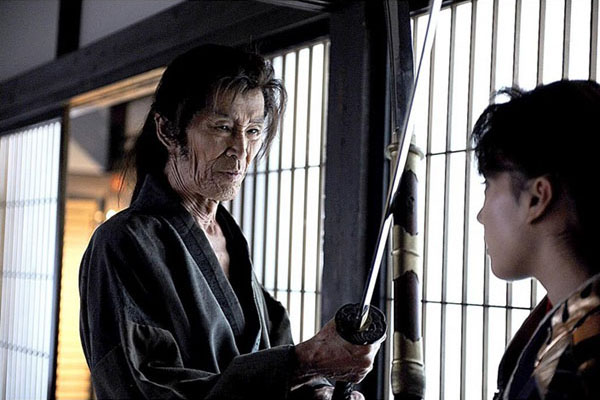
Uzumasa Limelight
2014, NR, 103 min. Directed by Ken Ochiai. Starring Seizo Fukumoto, Chihiro Yamamoto, Masashi Goda, Hirotaro Honda, Hisako Manda, Hana Ebise, Hidekazu Ichinose.
REVIEWED By Marc Savlov, Fri., Dec. 5, 2014
It’s a safe bet to say Takeshi “Beat” Kitano’s 2003 take on the perennially popular blind swordsman Zatoichi jump-started the flagging Japanese cinema and television genre known as chanbara. Prior to that, fans of these samurai-saturated, slash ’n’ dash sword-fighting films were better off rewatching any one of Akira Kurosawa’s many Edo-period epics, or digging deeper with Hideo Gosha’s insolently beautiful, 1965 masterpiece Sword of the Beast. It seemed for a moment that samurai films had gone the way of, well, the samurai. (Tom Cruise in The Last Samurai, anyone?) Kitano’s vision-impaired revamp kicked off a spate of chanbara films, not least among them Takashi Miike’s own riff on Zatoichi as well his bloody excellent 13 Assassins and the grueling Hara-Kiri: Death of a Samurai. (I’d be remiss in not mentioning Quentin Tarantino’s Kill Bill, also 2003, so there you go.)
Uzumasa Limelight focuses on a particular type of actor/stuntman key to the genre: the kirare-yaku or “sliced actor” who specialize in the ballet of violent death by sword. Director Oichai has crafted a heartfelt tribute to these intensely physical yet widely unsung men (and the occasional woman) that’s long overdue and well-deserved.
In a truly inspired bit of casting, real-life kirare-yaku (semi-)superstar Seizo Fukumoto, who has been sliced to ribbons some 50,000 times throughout his film and television career, here plays Seiichi Kamiyama, a revered stunt actor in the autumn of his years who has survived decades of J-pop culture’s fickle tastes only to find himself cast aside when his studio decides samurais are out and detectives-vs.-yakuza shows are in. Ochiai flashes back and forth between Seiichi’s early career and his current plight (his elderly body may be spry, but these days those body falls hurt), and makes the case that it’s not nostalgia if you actually did it, but yeah, the old ways had more inherent nobility than the new. (The move from practical effects-work to CGI blood sprays is duly noted.)
And Uzumasa Limelight is something of a love story, to boot, with aspiring actress Satsuki (Yamamoto) entering Seiichi’s life as his protégé in the niche, albeit grand, art of dying sensationally. They make a winning pair, complemented throughout the film by some deeply evocative compositions and lighting from Director of Photography Chris Freilich. It’s Fukumoto’s wonderfully weathered countenance that makes Ochiai’s film such an elegiac delight. On it, you can see the entire history of samurai cinema, or at least that essential part of it that died often, and beautifully so.
A note to readers: Bold and uncensored, The Austin Chronicle has been Austin’s independent news source for over 40 years, expressing the community’s political and environmental concerns and supporting its active cultural scene. Now more than ever, we need your support to continue supplying Austin with independent, free press. If real news is important to you, please consider making a donation of $5, $10 or whatever you can afford, to help keep our journalism on stands.
Aug. 7, 2022
April 29, 2022
Uzumasa Limelight, Ken Ochiai, Seizo Fukumoto, Chihiro Yamamoto, Masashi Goda, Hirotaro Honda, Hisako Manda, Hana Ebise, Hidekazu Ichinose







